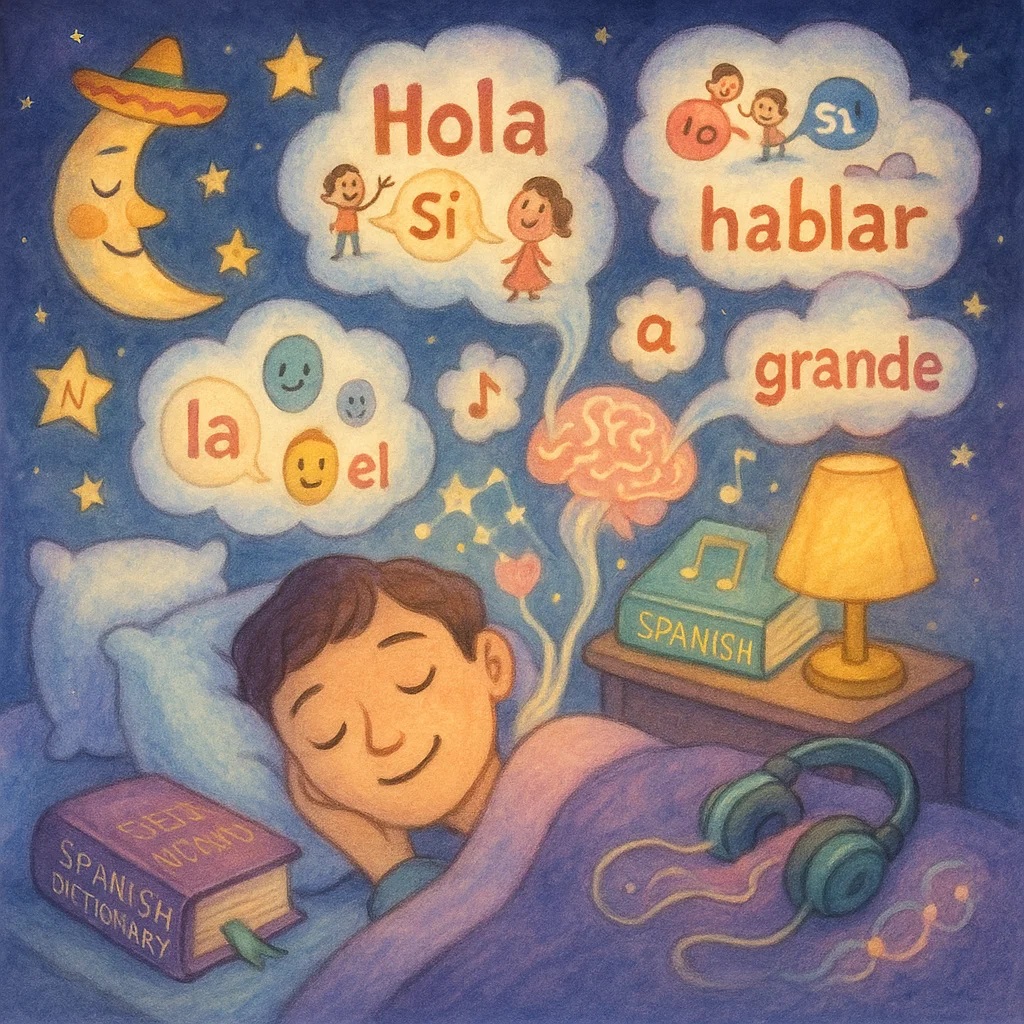Article created on May 26, 2025, article updated on May 26, 2025, by Sandra Sánchez

Content:
- Key Takeaways
- The Science Behind Sleep Learning for Spanish
- Visualization: Effectiveness of Different Spanish Learning Methods
- Top Resources for Spanish Sleep Learning
- Scientific Studies Supporting Sleep Learning
- Practical Tips for Maximizing Spanish Sleep Learning
- Realistic Expectations for Spanish Sleep Learning
- Your Nighttime Spanish Journey: Strategic Next Steps
- Frequently Asked Questions
Key Takeaways
- Sleep learning works best for reinforcing vocabulary you’ve already studied while awake
- Scientific research shows limited but real benefits of targeted audio during specific sleep phases
- Sleep-based learning should complement, not replace, traditional study methods
- Different sleep phases offer varying potential for language reinforcement
- Creating an effective sleep-learning routine requires strategic planning and realistic expectations
The Science Behind Sleep Learning for Spanish
Despite sounding like science fiction, research has uncovered fascinating connections between sleep and language acquisition. Your brain doesn’t simply shut down during sleep—it processes, consolidates, and reorganizes information acquired throughout the day.
Understanding Sleep Cycles and Learning Potential
Your sleep consists of multiple cycles, each containing different phases that influence learning potential:
| Sleep Phase | Duration | Learning Potential | Best Content Type |
|---|---|---|---|
| Light Sleep (N1) | 5-10 minutes | Moderate | Simple vocabulary review |
| Intermediate Sleep (N2) | 20 minutes | High | Known vocabulary, basic phrases |
| Deep Sleep (N3) | 20-40 minutes | Limited | Not recommended |
| REM Sleep | 10-60 minutes | High for memory consolidation | Already learned material |
Dr. Susanne Diekelmann, a neuroscientist specializing in sleep research at the University of Tübingen, explains: “Sleep plays a significant role in memory consolidation. While learning completely new information during sleep is unlikely, reinforcing previously acquired knowledge shows promising results.”
The Role of Repetition in Sleep Learning
Repetition emerges as the unsung hero in sleep-based language acquisition. Your sleeping brain responds to patterns, making consistent exposure to familiar Spanish words and phrases particularly effective.
A 2019 study published in Current Biology found that participants who heard previously studied foreign language vocabulary during slow-wave sleep showed improved recall the next day—scoring 10% higher on vocabulary tests compared to control groups who didn’t receive sleep reinforcement.
Case Study: Maria’s Sleep-Learning Experiment
Maria, a 34-year-old marketing professional with limited study time, experimented with sleep learning for three months. Her approach:
- 15 minutes of active Spanish vocabulary study before bed
- Audio playback of the same vocabulary during early sleep phases
- Regular testing to measure retention
Results: Maria showed 23% better retention of vocabulary compared to traditional study-only methods, but only for words she had actively studied before sleep. Completely new words played during sleep showed no significant retention improvement.

Visualization: Effectiveness of Different Spanish Learning Methods
Data based on retention rates measured across multiple language learning studies (2018-2022)
Top Resources for Spanish Sleep Learning
Ready to experiment with sleep learning? Let’s explore tools specifically designed to complement your nighttime Spanish acquisition.
YouTube Channels for Sleep Learning
Several content creators have developed specialized Spanish audio tracks optimized for sleep learning:
- SpanishPod101 – Offers 8-hour vocabulary loops with gradually decreasing volume
- Lingo Jump Channel – Specialized in phrase repetition with binaural beats
- Learn Spanish World – Features progressive vocabulary sessions with silent intervals
The most effective channels incorporate spaced repetition principles, allowing your brain to process information during optimal sleep phases. Look for content with natural pauses and gentle transitions between words or phrases.
Smartphone Apps for Spanish Sleep Learning
Modern technology offers sophisticated options for nighttime language reinforcement:
- Mosalingua Sleep Learning – Customizes audio based on your daytime study sessions
- Sleep and Learn Spanish – Uses sleep-cycle detection to optimize audio playback timing
- Spanish Head Start – Combines relaxation techniques with vocabulary introduction
Most effective apps include features that track sleep quality and adjust accordingly, ensuring the audio doesn’t disrupt your rest while maximizing learning potential.

Scientific Studies Supporting Sleep Learning
The field of sleep-based language acquisition continues to evolve, with research providing both encouraging findings and important limitations.
The “Dutch Words” Study
One of the most cited studies in this field comes from researchers at the University of Bern in Switzerland. Participants learned Dutch vocabulary while awake, then heard some of these words played back during slow-wave sleep. The next morning, they showed significantly better recall of the words played during sleep compared to those that weren’t.
Dr. Thomas Schreiner, lead researcher, notes: “Our findings suggest that sleep provides an optimal window for memory reactivation. However, it’s important to emphasize that participants had already learned the vocabulary while awake. Sleep merely reinforced existing memories.”
The Limitations of Sleep Learning
Not all research paints an optimistic picture. A comprehensive 2023 meta-analysis published in the Journal of Sleep Research examined 38 studies on sleep-based learning, concluding:
“While targeted memory reactivation during sleep shows promise for reinforcing existing knowledge, there is no substantial evidence supporting the acquisition of entirely new information during sleep. The most significant benefits appear when sleep learning supplements traditional waking study methods.”
This aligns with neurological understanding—your sleeping brain excels at strengthening neural pathways but struggles to create entirely new ones.
Practical Tips for Maximizing Spanish Sleep Learning
If you’re ready to experiment with this approach, implementing these strategies can help optimize your results:
Creating a Sleep Learning Routine
- Pre-sleep active study – Review the specific vocabulary or phrases that will play during sleep for 15-20 minutes before bed
- Optimize your environment – Ensure comfortable temperature, minimize disruptions, and consider using a headband headphone for comfort
- Set appropriate volume – Audio should be just audible but not disruptive to sleep (around 30-40% of normal listening volume)
- Use timers – Set audio to play for 45-90 minutes after falling asleep, then automatically stop
- Track results – Test retention the following day to determine what’s working
Daniel Martinez, a language coach who incorporates sleep learning techniques with his students, shares: “The key is consistency. One night of sleep learning won’t produce miracles, but three months of strategic implementation can yield noticeable improvements in vocabulary retention.”
Avoiding Common Sleep Learning Mistakes
Many enthusiasts undermine their efforts with these common pitfalls:
- Excessive volume – Too loud disrupts sleep quality, negating learning benefits
- Too much content – Focus on 20-30 words/phrases per session maximum
- Complex grammar – Sleep learning works best for vocabulary, not grammatical concepts
- All-night audio – Extended playback disrupts sleep cycles; limit to early sleep phases
- Inconsistency – Sporadic implementation prevents pattern recognition

Realistic Expectations for Spanish Sleep Learning
Setting appropriate expectations is crucial for anyone exploring sleep learning. This approach isn’t a shortcut to fluency but rather a potential enhancement to your existing language journey.
What You Can Realistically Achieve
Based on current research and practitioner experiences:
- 15-25% improved retention of actively studied vocabulary
- Better pronunciation through passive exposure to native speech patterns
- Reinforcement of simple phrases and expressions
- Potential improvement in auditory processing of Spanish sounds
Complementing Active Learning
Sleep learning shows the greatest promise when integrated with comprehensive language acquisition strategies:
Case Study: Carlos’s Integrated Approach
Carlos, a business professional preparing for an international assignment in Madrid, developed a multi-faceted approach:
- Daytime: 30-minute Spanish lessons with a tutor 3x weekly
- Evening: Review of vocabulary and phrases from lessons
- Sleep: Audio reinforcement of the day’s vocabulary
- Weekends: Immersion practice with Spanish-speaking conversation partners
After six months, Carlos achieved B1 proficiency level—faster than average but not miraculous. He credited sleep learning as “a valuable supplement that improved retention, but not a substitute for active engagement.”
The Role of Sleep in Overall Language Learning
Even without audio interventions, quality sleep fundamentally supports language acquisition. Professor Rebecca Gómez, who studies language acquisition at the University of Arizona, explains: “Sleep helps consolidate declarative memories, including vocabulary and patterns crucial for language learning. This happens naturally during normal sleep cycles.”
This means that prioritizing good sleep hygiene may be as important as any specific sleep learning technique.
Your Nighttime Spanish Journey: Strategic Next Steps
Ready to integrate sleep learning into your Spanish acquisition strategy? Consider this practical implementation framework:
- Start with a two-week trial – Test the approach with a small vocabulary set to gauge personal response
- Establish baseline measurements – Test your retention rates with traditional study first
- Implement gradually – Begin with 30-minute sessions during early sleep, extending as comfortable
- Evaluate objectively – Use spaced testing to measure actual improvement, not perceived benefit
- Adjust based on results – Modify timing, content type, and volume based on personal response
Remember that sleep learning represents just one innovative approach within the broader landscape of language acquisition techniques. The most successful language learners remain curious explorers—willing to experiment with diverse methodologies while maintaining realistic expectations.
As Dr. James McConnel aptly noted: “The best approach combines the efficiency of modern techniques with the timeless value of consistent practice. Sleep learning may open a new dimension to your language journey—not by replacing traditional methods, but by enhancing them in unexpected ways.”

Will you incorporate nocturnal Spanish into your learning routine? Perhaps tonight, as you drift into sleep, a few carefully chosen Spanish phrases might find their way into your dreams—and just maybe, into your waking vocabulary.
Frequently Asked Questions
Can complete beginners benefit from Spanish sleep learning?
Research indicates that sleep learning works best for reinforcing knowledge you’ve already acquired while awake. Complete beginners should first establish basic vocabulary and pronunciation through conventional study methods. Once you’ve built this foundation, sleep learning can help reinforce and consolidate what you’ve learned. Start with 15-20 minutes of active study before bed, focusing on the specific vocabulary that will play during your sleep.
Could sleep learning actually disrupt my sleep quality?
Yes, if implemented incorrectly. Audio that’s too loud or continues throughout the night can interfere with natural sleep cycles, potentially reducing both sleep quality and learning effectiveness. The optimal approach involves audio at a very low volume (just barely audible), limited to the first 45-90 minutes after falling asleep, coinciding with lighter sleep phases. Use a timer to automatically stop playback, and monitor your sleep quality using wearable devices if possible. If you notice increased fatigue or disrupted sleep, adjust your approach or discontinue sleep learning.
How does sleep learning compare to traditional Spanish study methods in terms of efficiency?
Sleep learning should be viewed as a supplement rather than a replacement for traditional methods. Research suggests that combining active daytime study with sleep reinforcement can improve retention by 15-25% compared to daytime study alone—a significant but not revolutionary improvement. The most efficient approach integrates multiple learning modalities: active study, immersion practice, conversation with native speakers, AND strategic sleep reinforcement. This comprehensive approach addresses different aspects of language acquisition while leveraging sleep’s natural memory consolidation functions.
Need a Personal Spanish Teacher?
Looking for a more personalized approach to mastering Spanish? Sandra Sanchez, the passionate and experienced teacher behind Spanish Barcelona, offers one-on-one and group lessons tailored to your needs and goals.
Whether you’re a beginner or looking to refine your skills, Sandra’s customized lessons will help you gain confidence and fluency in no time.
📌 Ready to get started? Leave your request today, and let’s make Spanish learning fun and effective for you!
